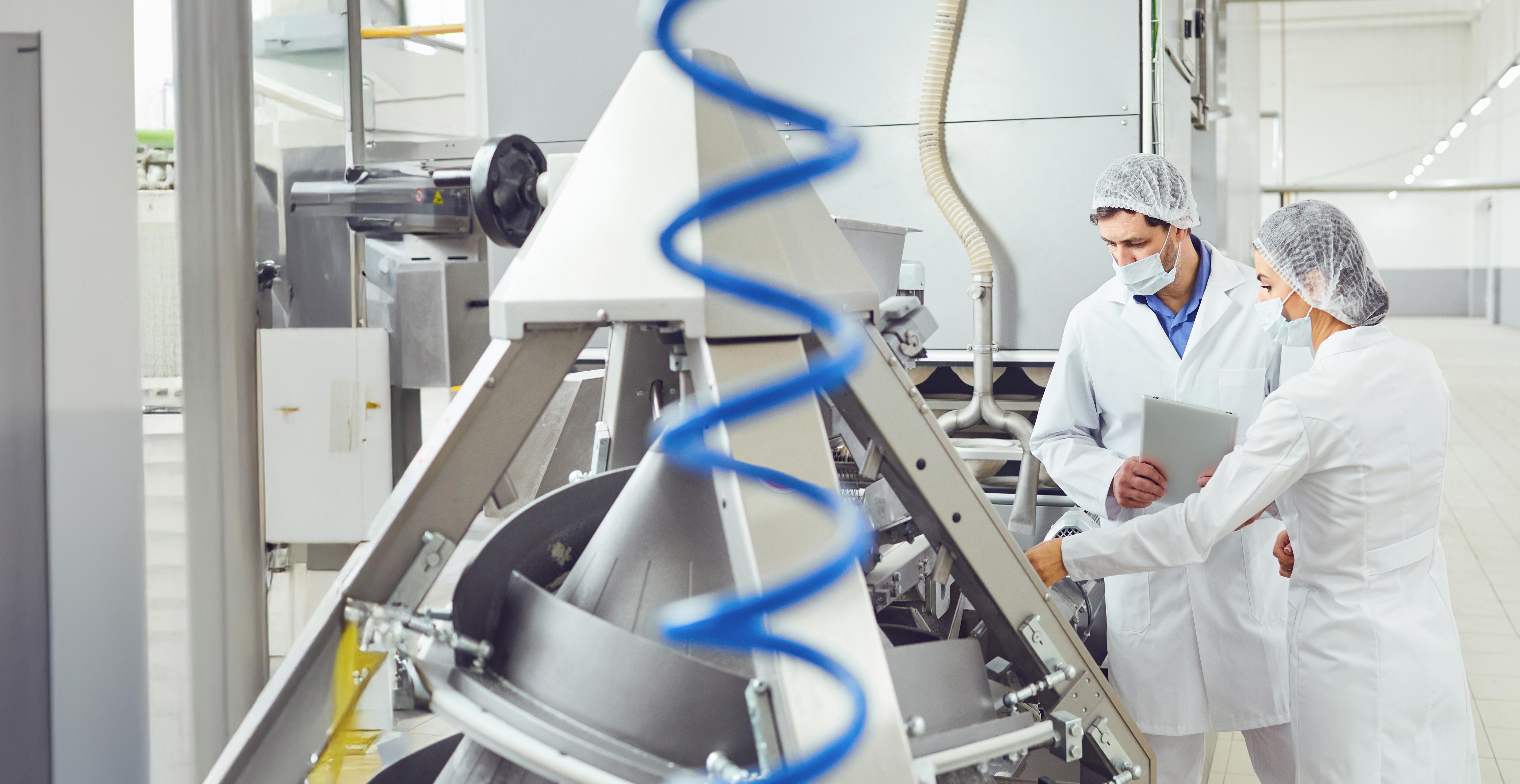End-to-End Digital Traceability:
FSMA 204 and Food Safety Compliance


End-to-End Digital Traceability:

Rising traceability standards and regulations like the Food Safety Modernization Act section 204 (FSMA 204) are requiring food and beverage businesses like yours to track product movement with speed, precision and digital documentation.
In this guide, we’ll walk you through what FSMA 204 really requires, what makes compliance achievable and how your team can build a connected foundation that withstands future scrutiny. We’ll explain what the regulation demands, why early action gives you an edge and how to build a system that meets rising traceability standards.


It Means for You
Across the food and beverage industry, regulatory bodies, major retailers and even voluntary certification programs are setting higher expectations for transparency and data accuracy. FSMA Section 204 is one of the most detailed examples of this shift, making it a useful benchmark for your compliance strategy. New mandates can feel complex especially when they impact compliance, consumer safety and day-to-day operations. FSMA 204 centers on two core requirements: critical tracking events (CTEs), which represent key points in a product’s journey, and key data elements (KDEs), the specific details you must capture at each of those points. These rules apply to a defined traceability list of high-risk foods, from fresh produce, cheeses, seafoods to ready-to-eat items—across receiving, transformation, creation and shipping activities.
To comply, you’ll need to pinpoint which ingredients and finished goods on your line fall under the rule. That includes how you track incoming lots, manage internal processes and send products downstream. Even with proactive steps, blind spots in your traceability process can still put your business at risk. Let’s walk through the most common gaps so you know exactly what to watch for, and why leading food and beverage companies are already moving toward end-to-end traceability, a standard that’s quickly becoming the industry norm.
Many food and beverage companies still run traceability processes on fragmented or outdated tools. These gaps limit visibility, slow compliance tasks and increase risk when auditors or regulators come calling.
These are the most common pain points that signal your current approach may not withstand FSMA 204 scrutiny:
» Reliance on paper logs, spreadsheets or binders that slow recordkeeping and introduce errors.
» Disconnected systems that fail to share data across production, inventory and logistics.
» Limited visibility into CTEs and KDEs across your supply chain, leaving traceability gaps.
» Lack of real-time lot-level tracking from ingredient intake through finished goods.
» Difficulty producing complete product histories quickly and with confidence.
» Delayed recall response times caused by manual lookups or incomplete records.
» Outdated systems that cannot scale with production growth or regulatory demands.
If these gaps apply to your business, it may be time to adopt food-specific enterprise resource planning (ERP) software. An ERP centralizes lot-level data that automates CTE and KDE capture. These capabilities create audit-ready traceability and faster recall response.

ERP forms the backbone of a connected compliance ecosystem— capturing, sharing and tracking Traceability data seamlessly from intake to delivery. Traceability starts with comprehensive visibility, and that means having accurate, real-time information across your entire operation. A food and beverage ERP centralizes information, standardizes workflows and supports the level of control FSMA 204 demands. With the right ERP in place, your team can document product movement and access records without relying on manual steps.
An industry-specific ERP is designed to capture bi-directional traceability data as part of everyday processes. Its built-in tools help reduce gaps in recordkeeping by streamlining data entry, improving lot-level accuracy and making critical information available when and where it’s needed.
An industry-specific ERP can deliver for your business:
» Faster, more confident recall readiness - ERP software supports lot-level tracking across your entire operation, so you can quickly trace products and respond with precision during audits or recalls.
» Streamlined FSMA 204 data compliance - By capturing KDEs and CTEs automatically, the system reduces manual entry and helps maintain accurate, regulation-ready traceability records.

» Improved food safety oversight - Built-in allergen and shelf-life management tools help your team monitor sensitive ingredients and expiration risks, minimizing the chance of noncompliant or unsafe shipments.
» Greater operational agility and control – With real-time visibility into production, inventory and supply chain activity you gain the insight to act fast, fix issues early and keep operations aligned with traceability goals.
» Consistent, standardized traceability records – An ERP solution enforces uniform data structures and integrates with key systems across your supply chain, helping you maintain consistent, interoperable records that align with FSMA 204 expectations.
With all your operational data flowing through one centralized system, ERP software becomes your single source of truth. It ensures traceability data is consistent, accessible and audit-ready.
But ERP shouldn’t operate in isolation. As your business grows, connecting additional systems extends visibility across your supply chain and strengthens food safety controls, helping you meet rising traceability standards with confidence.
Once your food and beverage ERP is in place as the foundation, the next step is extending visibility across your wider technology stack. Connecting your business systems helps ensure every record is updated, every handoff is traceable and every compliance task is easier to manage. The result is stronger compliance, faster response times and more confidence in every decision.
Here’s how connected tools contribute to traceability:
» Accurate product data from the start is achieved by integrating product lifecycle management (PLM), which adds formulations, labels, allergen details and version history into your traceability records.
» Stronger supplier and partner communication comes through electronic data interchange (EDI), which standardizes data exchange upstream and downstream.
» Full visibility through the last mile is supported by a transportation management system (TMS), which tracks shipping details and key data points including CTEs and KDEs for FSMA compliance.
» Controlled inventory movements and storage conditions are captured in a warehouse management system (WMS), ensuring lot handling is visible at every stage.
Together, these connections deliver:
» Comprehensive product context across formulations, suppliers, inventory and shipments.
» Faster recall response with product histories assembled automatically.
» Consistent audit readiness with standardized, regulationaligned records.
» Greater accuracy and efficiency through automated capture and fewer manual tasks.
When systems are connected, traceability shifts from a compliance burden to a source of operational strength— supporting food safety today and scalability tomorrow.

Digital traceability transformation doesn’t happen overnight—but a structured, phased approach helps you build momentum and reduce disruption. The following timeline is an average guideline designed for small to mid-sized food and beverage businesses. Some organizations may move faster, while others may require more time depending on their scale, complexity and resources. Larger enterprises often follow the same phases but may need extended timelines to account for broader operations and more stakeholders.
Begin with a full traceability audit, supported by both internal reviews with guidance from external experts when needed. Map your CTEs and KDEs, identify system and process gaps, and outline how those requirements should be addressed by technology. Bring QA/QC, IT, operations and supply chain leaders into alignment around a shared compliance roadmap.
a Unified Source of Truth
Next, identify the ERP software capabilities your business needs to close traceability gaps. Review potential vendors and focus on those with food-and-beverage expertise. Prioritize solutions that automate CTE and KDE capture and connect with the additional tools in your compliance roadmap. After selecting a partner, work collaboratively with the provider to deploy the ERP for centralized production, inventory and compliance data. This gives you a single, real-time view of traceability. It also reduces silos and ensures accurate data capture at every stage of production.
Phase 3: Month 10–15 | Extend Traceability With Connected Tools
Expand your capabilities by connecting complementary systems that support sanitation, supplier communication and logistics execution. Integrations across sanitation tracking, electronic data exchange, label specification management and delivery records help complete the digital thread—each system feeding into a centralized traceability record managed from a single operational platform.
Phase 4: Month 16 | Validate Performance and Prepare for Audits
Run internal audits and mock recall scenarios to confirm data completeness and system reliability. Teams should be trained to follow new protocols and document compliance procedures accurately. A centralized command center makes it easier to track compliance readiness and demonstrate traceability under pressure.
Phase 5: Month 17+ | Sustain and Strengthen Traceability Operations
Maintain momentum by continuously monitoring traceability KPIs through built-in dashboards. Schedule periodic audits, refresh user training and update your processes to reflect new risks and operational changes. A cloud-based platform simplifies system updates and ensures you stay aligned with FSMA 204 expectations and new regulations over time.
When it comes to FSMA 204, the cost of getting it wrong is too high. That’s why it’s critical to work with a software partner that knows the regulatory landscape, builds with compliance in mind— and has a track record of helping food and beverage companies get ahead of risk.

When food safety and compliance risk is on the line, it’s important to look beyond surface features and focus on long-term fit. Consider these factors when evaluating potential providers based on factors that directly impact these rising regulatory demands and standards.
What to look for in a traceability technology vendor:
» Food and beverage focus - A provider with direct experience in your industry is more likely to understand your traceability challenges and regulatory obligations, helping you avoid workarounds or costly missteps.
» FSMA-relevant capabilities - Look for software that supports built-in (not bolt-on) traceability tracking, capturing KDEs and CTEs through standard workflows. This streamlines processes and recordkeeping for audits and reduces administrative tasks to improve productivity.
» Connected software ecosystem - Ensure the vendor can provide an integrated platform that connects ERP, product lifecycle management (PLM), transportation management system (TMS), electronic data interchange (EDI) and other critical systems. This eliminates silos, maintains end-to-end traceability and supports visibility across your supply chain.
» AI-powered platform with centralized access - A secure cloud platform with a single access point like Aptean’s AppCentral platform makes it easier to manage tools, scale across sites and keep data current. Its built-in AI capabilities support smarter compliance tracking, automating routine tasks and surfacing insights that help teams respond faster to audits and recalls. Structured implementation supportImplementation should align with your workflows and industry standards. The right partner will offer clear guidance, proven best practices and standardization to accelerate adoption and reduce guesswork.

Across the industry, leading food and beverage companies rely on Aptean’s food and beverage software to meet FSMA 204 requirements with speed, accuracy and confidence, choosing a partner that understands the complexity of traceability and delivers technology built for food safety and compliance.
With Aptean’s food and beverage cloud-based software solutions, your traceability data is always current, organized and accessible, laying the groundwork for confident audits and faster recall response.
Built on Aptean AppCentral, your AI-powered connected workspace, you can simplify access to essential ready-to-use software tools and documents in one centralized hub, so your teams can manage compliance tasks, track progress and retrieve records fast when it matters most. Our connected platform automates workflows, supports cross-department collaboration and unites the tools you need to optimize your business from end to end.
Aptean brings deep industry expertise, a structured, proven implementation approach and technology built to help you comply with the highest traceability and safety standards across your entire business.



Navigate FSMA 204 compliance with confidence. Download this requirements checklist or take our determine your business readiness for the Food Traceability Final Rule.
Aptean is a global provider of industry-specific software that helps manufacturers and distributors effectively run and grow their businesses. Aptean’s solutions and services help businesses of all sizes to be Ready for What’s Next, Now®. Aptean is headquartered in Alpharetta, Georgia and has offices in North America, Europe and Asia-Pacific.
To learn more about Aptean and the markets we serve, visit www.aptean.com.
Aptean and Ready for What’s Next, Now are Registered Trademarks of Aptean, Inc. All other company and product names may be trademarks of the respective companies with which they are associated.